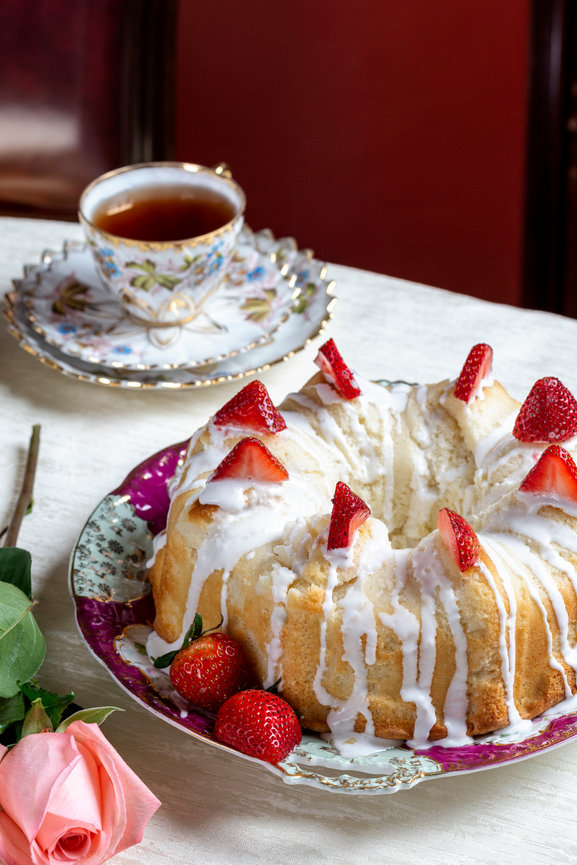Marble cake typically conjures up images of a beautifully swirled vanilla and chocolate cake, similar to the look of vanilla fudge ice cream. However, throughout most of the nineteenth century, the swirls in marble cake got their lovely chestnut color from molasses and rich spices such as nutmeg, cinnamon and cloves, not chocolate.
As I mentioned in a previous post, chocolate as a cake flavoring in America didn’t start appearing in cookbooks until the latter part of the nineteenth century. Prior to this, chocolate was consumed mainly as a beverage. In fact, the earliest recipes labeled “chocolate cake” were meant to be eaten with hot chocolate and actually contain no chocolate at all. In the late 1870s improvements in cocoa processing created a much smoother, more delicious tasting chocolate, which better translated to cake baking.
So when Anna Maxwell of the Ebenezer Maxwell Mansion began compiling a journal of recipes in the mid-nineteenth century, molasses was still the ingredient of choice for two-toned marble cakes. In fact, in addition to the marble cake, her journal has several other recipes featuring molasses, including gingerbread, gingersnaps, molasses cake and Dolly Varden cake (comprised of colorful multi-hued layers).
Molasses was an extremely important food ingredient in America’s early days. It first made its way to the colonies from the Caribbean as a by-product of the lucrative sugarcane industry. The British had began cultivating sugarcane in Barbados in the mid-1600s, and by the 1670s, there was a booming trade between Barbados and Rhode Island. The New England colonists would receive sugar, molasses, cotton and rum in return for products such as pork, beef, butter and cider. Since it was less expensive than refined sugar, thick, gooey molasses became the sweetener of choice throughout much of America. The rich liquid was incorporated into many recipes and used to brew birch and molasses beer and distill rum. When the price of refined sugar dropped at the end of the nineteenth century, the role of molasses diminished.
Not surprisingly, this is right around the time molasses and brown sugar in marble cake recipes began to be replaced by chocolate. For several years, both types of marble cake were often listed in cookbooks, but by the early twentieth century, chocolate had pretty much taken over, evolving into the extremely popular flavor that it is today. Either type of marble cake is excellent, but I highly recommend trying Anna’s version, especially in the fall or winter when heartier baked goods are appreciated. It would be a lovely addition to your Thanksgiving or holiday table!
The original recipe from Anna’s diary:
MARBLE CAKE-Light part-Two cups of white sugar, one cup of butter, a half-cup of sweet milk, whites of four eggs, two and one-half teaspoons of baking powder, two cups of flour. Dark part-One cup of brown sugar, a half cup of molasses, one cup of butter, one-fourth of a cup of sour milk, half a teaspoon of soda, yolks of four eggs, flour to thicken, and flavor.
My adapted version (this recipe makes enough batter for two round cakes two loaf cakes, two dozen cupcakes or a Bundt cake):
Light part:
- 4 egg whites
- 1 cup sugar
- 1 stick butter, softened
- ½ cup milk
- 1 ½ tsp baking powder
- 2 cups sifted cake flour
Dark part:
- 1 cup brown sugar
- ½ cup molasses
- 1 stick butter, softened
- ¼ cup sour cream
- 4 egg yolks
- 2 cups sifted cake flour
- ½ tsp baking soda
- 1 tsp freshly grated nutmeg
- 1 tsp cinnamon
- ½ tsp allspice
- ¼ tsp cloves
- Preheat oven to 350F. Butter pan(s) and dust with flour or line with parchment paper or cupcake papers.
- Beat egg whites until foamy, about 1-2 min. Set aside.
- Beat butter until light, about 1 minute. Add sugar ¼ cup at a time, beating 20 to 30 seconds after each addition. Slowly add milk and eggs and mix well.
- Add flour and baking powder a little at a time until thoroughly incorporated. Set aside.
- In a separate bowl, beat brown sugar, molasses and butter together, then add sour cream and egg yolks. Mix well. Sift flour with spices and baking soda and slowly add to mixture.
- Add light and dark batter to pan(s) in alternate intervals. When done, run a knife through the batter a few times to create a swirly pattern.
- Bake for 50-60 min if using a Bundt pan; 20-25 for cupcakes and 30 min for 8-in circular cake pans, or until a toothpick inserted into top comes out clean.
- Cool on wire racks and ice with sugary glaze if desired (1 cup confectioners sugar, 3 tbsp cream and 1 tsp vanilla).
(Sources: Baking in America by Greg Patent; The Oxford Companion to American Food and Drink edited by Andrew F. Smith
For more of Anna Maxwell's recipes, click here.






0 Comments